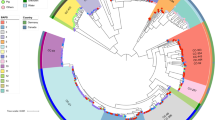Abstract
We analyze recombination in C. jejuni using MLST data from isolates taken from wild birds, cattle, wild rabbits, and water in a 100-km2 study region in Cheshire, UK. We use a recent approximate likelihood method for inference, based on combining likelihood information from all pairs of segregating (polymorphic) sites in the data. We find substantial evidence for recombination, but only for recombination with short tract lengths, of around 225–750 bp. We estimate that the rate of recombination is of a similar magnitude to the rate of mutation.


Similar content being viewed by others
References
Awadalla P (2003) The evolutionary genomics of pathogen recombination, Nature Rev genet 4:50–60
Claus H, Maiden MCJ, Maag R, rosch M, Vogel U (2002) Many carried meningococci lack the genes required for capsule synthesis and transport. Microbiology-SGM 148:1813–1819
Colles FM, Jones K, Harding RM, Maiden MCJ (2003) Genetic diversity of Campylobacter jejuni isolates from farm animals and the farm environment. Appl Environ Microbiol 697409–7413
De Boer P, Wagenaar JA, Achterberg RP, van Putten JPM, Schouls LM, Duim B (2002) Generation of campylobacter jejuni genetic diversity in vivo. Mol Microbiol 44 351–359
Donnelly P, Tavare S (1995) Coalescents and genealogical structure under neutrality. Annu Rev Genet 29 401–421
Falush D, Kraft C, Taylor NS, Correa P, Fox JG, Achtman M, Suerbaum S (2001) Recombination and mutation during long-term gastric colonizaion by Heliicobacter pylori: Estimates of clock rates, recombination size, and minimal age. PNAS 98 15056–15061
Falush D, Wirth T, Linz B, Pritchard JK, Stephens M, Kidd M, Blaser MJ, Graham DY, Vacher S, Perez-Perez GI, Yamaoka Y, Megraud F, Otto K, Reichard U, Katzowitsch E, Wang XY, Achtman M, Suerbaum S (2003), Traces of human migrations in Helicobacter pylori populations. Science 299 1582–1585
Fearnhead P (2003). Consistency of estimators of the population-scaled recombination rate. Theoret Popul Biol 64 67–79
Fearnhead P, Donnelly P (2001), Estimating recombination rates from population genetic data. Genetics 159 1299–1318
Feil EJ, Smith JM, Enright MC, Spratt BG (2000). Estimating recombinational parameters in Streptococcus pneumoniae from multilocus sequence typing data. Genetics 154 1439–1450
French NP, Barrigas M, Brown P, Ribiero P, Williams NJ, Leatherbarrow H, Birtles R, Bolton E, Fearnhead P, Fox A (2005) Spatial epidemiology and natural population structure of Campylobacter jejuni colonising a farmland ecosystem. Environ Microbiol (in press)
Frisse L, Hudson RR, Bartoszewicz A, Wall JD, Donfack J, Di Rienzo A (2001) Gene conversion and different population histories may explain the contrast between polymorphism and linkage disequilibrium levels. Am J Hum Genet 69: 831–843
Hilliker AJ, Harauz G, Reaume AG, Gray M, Clark SH, Chovnick A (1994) Meiotic gene conversion tract length distribution within the rosy locus of Drosophila Melanogaster Genetics 137: 1019–1026
Hudson RR (2001) Two-locus sampling distributions and their application. Genetics 159: 1805–1817
Hudson RR (2002) Generating samples under a Wright-Fisher neutral model of genetic variation. Bioinformatics 18: 337–338
Hudson RR, Slatkin M, Maddison WP (1992) Estimation of levels of gene flow from DNA-sequence data. Genetics 132: 583–589
McVean GAT, Awadalla P, Fearnhead P (2002). A coalescent method for detecting recombination from gene sequences. Genetics 160: 1231–1241
McVean GAT, Myers SR, Hunt S, Deloukas R, Bentley D, Donnelly R (2004), The fine-scale structure of recombination rate variation in the human genome. Science 304; 581–584
Rambaut A, Crassly NC (1997) Seq-Gen; an application for the Monte Carlo simulation of DNA sequence evolution along phylogenetic trees. Comput Appl Biosci 13: 235–238
Schouls LM, Reulen S, Duim B, Wagenaar JA, Willems RJL, Dingle KB, Colles PM, Van Embden JDA (2003) Comparative genotyping of campylobacter jejuni by amplified fragment length polymorphism, multilo-cus sequence typing, and short repeat sequencing; Strain diversity, host range, and recombination. J Clin Microbiol 41: 15–26
Smith NGC, Fearnhead P (2005) Comparative performance and robustness of three estimators of the recombination rate. Genetics (in press)
Stumpf MPH, McVean GAT (2003) Estimating recombination rates from population-genetic data. Nature Rev Genet 4: 959–968
Suerbaum S, Lohrengel M, Sonnevend A, Ruberg F, Kist M (2001) Allelic diversity and recombination in Campylobacter jejuni. J bacterial 183: 2553–2559
Wall JD (2004) Estimating recombination rates using three site likelihoods. Genetics 167: 1461–1473
Wiuf C, Hein J (2000) The coalescent with gene conversion. Genetics 155: 451–462
Acknowledgments
This work was supported by EPSRC grant GR/S18786/01, and by the Environment Institute and the Department for Environment, Food and Rural Affairs (DEFRA). We thank Daniel Falush for helpful comments.
Author information
Authors and Affiliations
Corresponding author
Additional information
[Reviewing Editor: Dr. Magnus Nordborg]
Rights and permissions
About this article
Cite this article
Fearnhead, P., Smith, N.G., Barrigas, M. et al. Analysis of Recombination in Campylobacter jejuni from MLST Population Data. J Mol Evol 61, 333–340 (2005). https://doi.org/10.1007/s00239-004-0316-0
Received:
Accepted:
Published:
Issue Date:
DOI: https://doi.org/10.1007/s00239-004-0316-0




